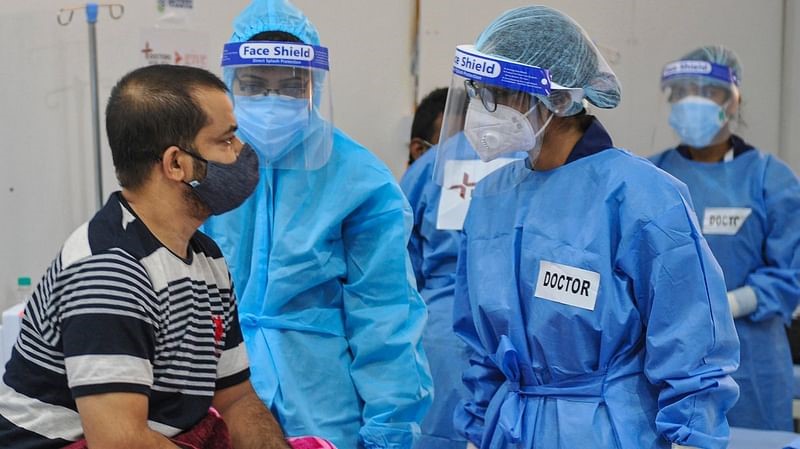
There’s talk of COVID 4th wave; what exactly constitutes a wave?
Oxford University scholars said the term “wave” comes from the 1889-92 influenza outbreak that had different phases supposed to have occurred over multiple years

There has been an increase in the number of new COVID cases in India. Due to this, there are fears that a fourth wave is coming. Also, there is a possibility of mini waves.
According to the World Health Organization (WHO) chief scientist Dr. Soumya Swaminathan, test positivity rate and hospitalisations indicate another wave in the country.
Also read: Long COVID in infected children: New study reveals top symptoms
“Epidemiological factors such as test positivity rate and hospitalisations indicate another wave. But this wave may not be clearly visible in the graph because testing is low. Most people are confident vaccination will protect them from severe disease,” Dr. Swaminathan was quoted as saying by Times of India.
She also added that there is a possibility of mini waves every four to six months. “The sub-variants that are emerging are more transmissible than the original Omicron BA.1 and there is a likelihood of waning immunity. It is a possibility that there could be mini waves every four-six months or so and hence, apart from all Covid-appropriate precautionary measures that need to be taken, it is important to also track the variant,” Dr. Swaminathan told Indian Express.
What is a wave?
According to Marc Lipsitch, director of the Centre for Communicable Disease Dynamics at the Harvard School of Public Health, there is no agreed definition for a wave – it simply refers to a sustained upsurge in cases.
“A wave is just a metaphor. It is not a term with a precise definition in epidemiology, but it is a useful metaphor indicating that from whatever level of daily new case incidence we have, there is an increase,” he told the ABC.
Also read: Even vaccinated people can develop long COVID, study finds
Abram L. Wagner, Research Assistant Professor of Epidemiology, University of Michigan, wrote in The Conversation that there is no strict definition for what is or is not an epidemic wave or phase. “Disease waves aren’t scientifically defined,” he said.
“A wave implies a rising number of sick individuals, a defined peak, and then a decline. The word wave implies a natural pattern of peaks and valleys; it hints that even during a lull, future outbreaks of disease are possible,” he said.
“Historical outbreaks of infectious diseases offer some models for how the course of a disease like COVID-19 might unfold over time. Some diseases come in somewhat predictable seasonal waves, with higher transmission rates at some times of the year than at others,” he added.
Also read: Delta variant driving fourth wave of COVID in Middle East: WHO
University of Oxford scholars of evidence-based medicine Tom Jefferson and Carl Heneghan said the term “wave” comes from the 1889-92 influenza outbreak that had different phases supposed to have occurred over multiple years. It had three waves.
“Waves, as in the sea, are usually preceded by a trough, but this visual analogy is hardly ever mentioned; nor the appropriateness of forecasting waves in a coronavirus pandemic,” they explained.
“Waves imply a lack of viral circulation which is probably an illusion. It is possible that some of the waves or phases were caused or favoured by co-circulation of other microorganisms. Waves are also visible and mostly rhythmical,” they opined.
The 1918 H1N1 “Spanish flu” pandemic is described as having several waves. However, Stephen Morse, PhD, of Columbia University Mailman School of Public Health in New York City told MedPage Today that a wave is a biological phenomenon, and it’s not clear how to determine if a wave has transpired.
“It’s not particularly scientific: how you define a wave is arbitrary,” Dr. Mike Tildesley, from the University of Warwick, told BBC.
What does WHO say?
As per the WHO, for one wave of a pandemic to end, “the virus has to be brought under control and cases have to fall substantially Then for a second wave to start, you need a sustained rise in infections”.
Also read: Over 42 lakh deaths in India prevented by Covid vaccines in 2021: Lancet study
“Previous pandemics have been characterized by waves of activity spread over months. Once the level of disease activity drops, a critical communications task will be to balance this information with the possibility of another wave. Pandemic waves can be separated by months and an immediate “at-ease” signal may be premature.
“In the post-pandemic period, influenza disease activity will have returned to levels normally seen for seasonal influenza. It is expected that the pandemic virus will behave as a seasonal influenza A virus. At this stage, it is important to maintain surveillance and update pandemic preparedness and response plans accordingly. An intensive phase of recovery and evaluation may be required,” the WHO added.
What ICMR said
Recently, a top health expert from the Indian Council of Medical Research (ICMR) ruled out a fourth wave coming to the country.
Samiran Panda, the Additional Director General of the ICMR, told ANI, “It’s wrong to say the fourth wave is coming, we need to examine district-level data. A high number of cases in a few districts can’t be considered a uniform increase in cases across the country. Not every variant is variant of concern.”
Also read: Fourth wave fears loom as April sees gradual rise in COVID cases

